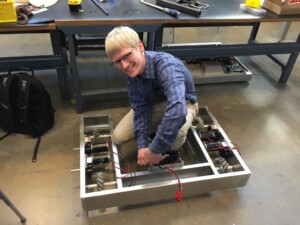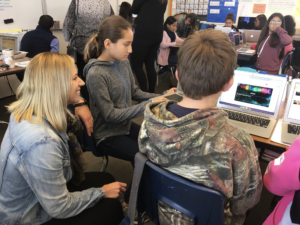Las Vegas: Downtown Project, Blended Progress

“Education is the bedrock on which a truly great city is built,” according to Tony Hsieh and the Downtown Project – his $350 Million dollar investment fund. The CEO of shopping giant Zappos is leading efforts to help reimagine the old city center north of the Las Vegas Strip. It’s one of several promising efforts to reverse the economic freefall that started in 2008 and create a vibrant dense urban core and “the most community-focused large city in the world.
Edward L. Glaeser’s Triumph of the City inspired Hsieh to found Downtown Project to help transform downtown Las Vegas into a dynamic urban center. Downtown Project’s goal and purpose is to help make downtown Las Vegas a place of Inspiration, Entrepreneurial Energy, Creativity, Innovation, Upward Mobility, and Discovery, through the 3 C’s of Collisions, Co-learning, and Connectedness in a long-term, sustainable way. An explosion of activity encompassing art, culture, business formation, and a new school development are now part of a $350 million five year project. Of that initial investment, funds have been allocated to a $50 million fund to invest in small businesses; $50 million for the VegasTechFund to invest in tech startups; $50 million for arts, education, and culture including the monthly First Friday arts festival and a private school focused on brain-based education, social-emotional learning, and entrepreneurship; and $200 million for real estate and development.
Downtown Project encourages learning by hosting monthly speaker series focused on tech, fashion, along with Catalyst Week and Creativ Week –an exploration of strategic partnerships in philanthropy, wellness, music, fashion, education, and technology. The Downtown Speaker Series brings thought-provoking speakers to town every month. It just may be the most interesting urban revitalization project in the country.
Cool Schools. Last year Clark County Public Schools served 314,643 students in 357 schools with a budget of $2.2 billion. Despite losing a half billion in funding over the last five years, CCPS boosted grad rates from 58% to 71%. With per pupil expenditures of $8k, Clark spends a lot less than the 5 larger districts in the country (see Open Book for some comparisons).
Started in 2009, the Las Vegas Math Initiative is a community partnership to help teachers elevate student math achievement with a target impact of 15,000 students in 27 schools. The six year initiative of MIND Research Institute provides schools with K-5 visual based math program ST Math, training and support for teachers and admins. At Jeffers Elementary, over 120 of the 150 new kindergarteners spoke no English on the first day of school, with a similar percentage of students living in or near poverty. While the school is close to 1:1 access, it’s a hodge podge of old desktops, laptops, and tablets (making it a challenge to administer an online writing assessment, for example). Teachers like Daniel Cano (a Rookie Teacher of the Year last year) align ST Math games with Investigations, their core curriculum, and make the most of mixed forms of access with a classroom rotation model that gives him time to work with small groups of struggling students.
Across the street from Jeffers is Von Tolen Middle School, one of five middle schools in the county piloting 1:1 iPads as part of the Engage, Empower, Explore Project (E3)–one of 12 1:1 pilot schools. Principal Roger Gonzales is participating in the Executive Leadership Academy which plans to add another 3 schools to the e3 Project. “To see the structural change over the year has been amazing,” said district CTO Jhone Ebert about an E3 classroom visit last year. “Within 20 seconds the students were on their iPads taking a quiz on Edmodo. They then broke up into groups to work on a caste system presentation. Students were allowed to work in the hallway on their projects. As I walked around and spoke to all of the students they could not imagine going back to a learning environment without this tool.”
The Clark County School District (CCSD) has a well developed network of magnet schools. A couple we learned about include:
- Walter Bracken STEAM Academy–a 51 year old elementary facility rejuvenated by murals, raised beds, trees, a turtle park and mini-amphitheater–is led by award winning Katie Decker, an energetic and insightful educator. Grade level teams make use of a wide range of digital tools.
- Southwest Career and Technical Academy is a high school, led by Felicia Nemcek, with eleven areas of study that include “rigorous coursework, hands-on projects, job-shadowing, and internships.” It makes me smile to see a high school principal with a PBL sticker (from BIE.org) on her Air. Southwest is high tech–recognized as an Apple Distinguished School two years in a row–and, Ebert noted, “The entire student body understands what it means to be a community.” For example, “The fashion design students not only sew clothes for students in need but the teach low income parents this skill as well.”
Nevada has 13 state approved district online programs–the largest being Nevada Learning Academy at CCSD providing online coursework for over 30,000–and seven online charter schools including Nevada Connections Academy and Nevada Virtual Academy.
Nevada improved from a D on the Digital Learning Now Report Card to a B in 2013 with improved access to digital learning opportunities. Vegas hosted the 2014 Charter School Conference (where Tom presented on funding partnerships and blended SpEd). However, Clark County scored a middle-of-the-pack D on the Brookings Choice Index reflecting a lack of charter schools.
The state spent $50 million to improve elementary schools with high percentages of English language learners. The 14 in Clark County are showing positive early results from more pre-kindergarten classrooms, creating reading centers and extending the school year
CCSD has a number of schools that benefited from federal School Improvement Grants. Hancock Elementary is a turnaround school that fulfilled grant expectations (see Sun story). “Technology is used to personalize instruction and meet the needs of ALL students,” said Ebert. And, “Leadership matters!”
Former superintendent Dwight Jones said Ebert, “has been nothing short of amazing in her efforts,” to get 100,000 students online or in a blended environment by fall 2015. “She finds ways to work with staff, lead in training and manage short funding to make our goal a reality for thousands of students.”
One positive sign of continued progress on the blended front is that CCSD joined with other large districts in an initiative based on five Reach Extension Principles and supported by Public Impact. “Out of the 18,000 teachers in our district, we know we have so many who could have a greater impact on student achievement,” says Staci Vesneske, chief human resources officer. “We just need to create opportunities for them to do so.”
Starting with the 2014-15 school year, Infinite Campus, the new student information system, will be used to provide information to parents on their child’s achievement.
Wynning Orgs. Ask Elaine Wynn what’s making a difference in the valley, and she’ll say, “Teach for America and Communities In Schools.” TFA Vegas, led by Victor Wakefield, has 170 crew members this year. Wynn and Hsieh are big TFA supporters. CIS works with schools to create a web of support for students and families. By incorporating CIS’ evidence-based work into the overall school improvement strategy, teachers are freed up to create powerful learning experiences and students show up ready to learn. (CIS was featured in SSIR’s What Works in Education.) Wynn chairs the national CIS board and is a CIS Nevada board member.
The Public Education Foundation develops great school leaders. They host several leadership summits each year focused on strategic thinking, solution driven innovation, and performance-based decision making. Their Executive Leadership Academy is a 15 month intensive development opportunity for experienced education and business leaders committed to transforming public education. The foundation also runs college scholarship, teacher support, reading, and volunteer programs.
Conclusions. Clark County schools serve a large and challenged population with relatively low levels of funding. The school district is a member of the Portfolio School District Network, but it doesn’t appear to have fully embraced strong accountability, school autonomy, and multiple providers.
There is less university influence in Vegas than other cities; there is innovation infrastructure for tourism but not much for technology or learning. The Downtown Project is an encouraging initiative that combines culture building with business development–a potential national model that could bolster the innovation infrastructure.
A Las Vegas Weekly post suggested that given the level of challenge, Clark County could be a great place to innovate. This series has identified a Smart Cities agenda that outlines a path for education and employment. Accordingly, Vegas leaders need to:
- Study how Mind Trust Developed The Smart Cities Formula.
- Work with CRPE to better implement the 7 components of a portfolio strategy.
- Build autonomous networks around successful magnets like Bracken and Southwest.
- Work with a local philanthropist to create a blended learning funder and assistance provider like Silicon Schools to accelerate and improve on Ebert’s goal of 100 blended schools in three years.
- Add a Tech Center, like Baltimore’s Digital Harbor Foundation, to the plans of the Downtown Project.
- Import a couple great blended networks like Summit, Rocketship, and Carpe Diem,
- Build a great innovation incubator like 4.0 Schools in NOLA.
- Join the League of Innovative Schools to leverage smart demand.
- Expand human capital efforts of Public Education Foundation (PEF) and TFA.
- Wrap schools in a web of support with CIS.
- Boost access to postsecondary with innovative dual enrollment options, and
- PEF should join the CEE-Trust network to explore ways to accelerate all of the above.
The Downtown Project is the most interesting and eclectic urban development project in the country. Connecting it to the districts blended learning plans and supercharging it with an innovation infrastructure could change the course of Clark County.
MIND Research Institute and Digital Learning Now are Getting Smart advocacy partners.






0 Comments
Leave a Comment
Your email address will not be published. All fields are required.